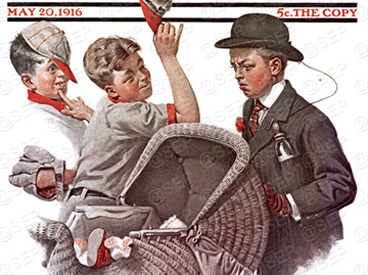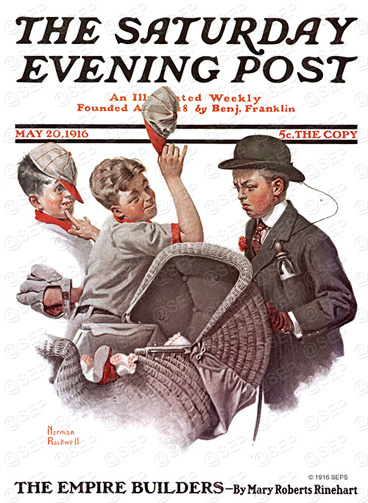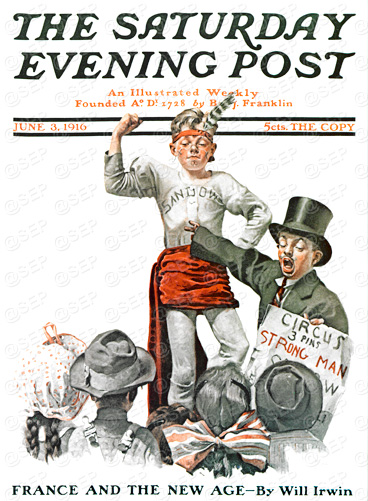How did Norman Rockwell (1894-1978) begin painting covers for The Saturday Evening Post? We are celebrating Rockwell’s February 3 birthday with his first three Post covers and the stories of how they came about.
The Baby Carriage
The Baby Carriage
Norman Rockwell
May 20, 1916
In his early 20s, Rockwell was an illustrator and art editor for Boys’ Life magazine. But, according to Rockwell in My Adventures as an Illustrator, he was tired of being accepted only by children’s publications and fed up with seeing “the Rover Boys and their lousy dog with the Mounted Police” on his easel. He dreamed of his art on the cover of The Saturday Evening Post; the thought of having his paintings viewed by millions excited daydreams of being famous: “surrounded by admiring females, deferred to by office flunkies at the magazines, wined and dined by the editor of the Post, Mr. George Horace Lorimer.” But that was the rub. Twenty-two-year-old Rockwell was petrified by the thought of approaching “the baron of publishing” who had “built the Post from a two-bit family magazine with a circulation in the hundreds” to a major publication with millions of readers. He had heard the publisher was tough. What if Lorimer didn’t like his work?
Rockwell had a friend named Clyde Forsythe, a cartoonist who knew his way around the world of commercial art. Forsythe was also straightforward. He was the only person Rockwell knew who wouldn’t just ooh and ah over his work, but would give an honest evaluation. He visited Rockwell one day and found the dejected artist lying on a cot in his studio. He asked Rockwell what was eating him, and Norman “hemmed and hawed but finally told him.” Forsythe’s advice: “‘Stop chewing on your tongue and do a cover. What the hell, you’re as good as anybody. Lorimer’s not the Dalai Lama.’”
So Rockwell did a couple of paintings, both attempts to mimic the high society images the Post favored at the time: one a romantic scene with a debonair pair of lovers in the style of Charles Dana Gibson and the other a beautiful ballerina curtsying under a spotlight. Forsythe returned and denounced them as “‘C-R-U-D, crud,’” noting Rockwell was a guy who just couldn’t paint beautiful women. Then he snatched up one of the illustrations Rockwell had just completed for a story in Boys’ Life. “‘Do that,’ said Clyde. ‘Do what you’re best at. Kids. You’re a terrible Gibson, but a pretty good Rockwell.’”
It was sound advice. On his first meeting with Post Art Editor Walter M. Dower, Rockwell sold two paintings (The Baby Carriage and The Circus Strongman) and had three sketches for future covers approved (including Gramps at the Plate). Though his work had been OK’d by Lorimer, Rockwell had yet to meet the publisher; instead it was Dower who informed him that he would receive $75 for each cover. Rockwell’s monthly salary as art director and illustrator for Boys’ Life was $50; he was over the moon. His first cover The Baby Carriage appeared on May 20, 1916.
(The story above was adapted from My Adventures as an Illustrator by Norman Rockwell.)
The Circus Strongman
The Circus Strongman
Norman Rockwell
June 3, 1916
1916 was something of a golden year for America. The economy was good and it was the last year before the U.S. entered into World War I. And boys dreamed of becoming the great strongman, Eugen Sandow. Showman Florenz Ziegfeld made a star of Sandow, who would lift weights, pose, and even break chains across his chest for audiences. Edison Studios did a short film of Sandow posing and flexing. This was the stuff of dreams for young boys.
Posing children would be a challenge to any artist, and getting a child to maintain a pose long enough to sketch the scene was difficult. But Rockwell had a way of dealing with the restlessness. At the beginning of each modeling session with kids, he set a stack of nickels on a table next to the easel. Every 25 minutes, he would take 5 nickels from the stack and set it aside, telling the model, “Now, that’s your pile.” Five cents in 1916 would be about a dollar in today’s money, and watching the coins pile up was great motivation. The model for “Sandow” was Billy Paine, who posed as all three boys in The Baby Carriage above. Rockwell used Paine in several Post covers. Sadly, Paine died at age 13; he’d been horsing around a second-story window and fell. “He was the best kid model I ever used” Rockwell said.
Gramps at the Plate
Gramps at the Plate
Norman Rockwell
August 5, 1916
The young artist still hadn’t met the powerful publisher, George Horace Lorimer, but was dealing with Walter Dower, the art editor. Rockwell’s first two finished paintings were accepted without any changes, but when Rockwell submitted his third painting—the baseball-playing grandfather—he found out being a Post cover artist wasn’t so easy after all. In My Adventures as an Illustrator, Rockwell tells the story of this cover:
“Mr. Dower brought word out that Mr. Lorimer thought the old man was too rough and tramplike. Would I do the painting over? Of course. I stretched a new canvas and began again. ‘Better,’ said Mr. Dower. ‘Mr. Lorimer thought it was better. But the old man’s too old, he thought.’ I did the painting over again. The boy was too small. I did that painting over five times before Mr. Lorimer accepted it.”
Later, Lorimer informed Rockwell that he had been testing him. Why? To test the new artist’s versatility, his ability to take direction, his perseverance, or maybe just to see if Rockwell would do his bidding. Whatever the reason for the test, the ordeal almost caused the young artist to give up: “I wonder if he ever knew how near I came to flunking his test.”
Become a Saturday Evening Post member and enjoy unlimited access. Subscribe now






